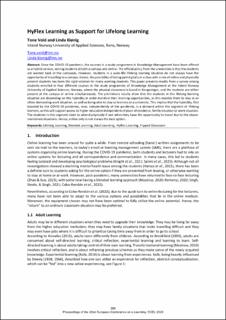| dc.contributor.author | Vold, Aud Tone | |
| dc.contributor.author | Kiønig, Linda Vibeke | |
| dc.coverage.spatial | Norway, Innlandet | en_US |
| dc.date.accessioned | 2024-03-15T13:47:20Z | |
| dc.date.available | 2024-03-15T13:47:20Z | |
| dc.date.created | 2023-10-25T16:14:09Z | |
| dc.date.issued | 2023 | |
| dc.identifier.citation | European Conference on e-Learning. 2023, 22 (1), 358-363. | en_US |
| dc.identifier.issn | 2048-8637 | |
| dc.identifier.uri | https://hdl.handle.net/11250/3122703 | |
| dc.description.abstract | Since the COVID-19 pandemic, the courses in a study programme in Knowledge Management have been offered as a hybrid version, serving students at both a campus and online. The official policy from the universities is that the students are wanted back at the campuses. However, students in a work-life lifelong learning situation do not always have the opportunity of travelling to a campus. Hence, the possibility of taking part digitally in a class with a mix of online and physically present students has been the right solution for many working students. This paper presents results from a survey among students enrolled in four different courses in the study programme of Knowledge Management at the Inland Norway University of Applied Sciences, Norway, where the physical classroom is based in Kongsvinger, and the students are either present at the campus or online simultaneously. The preliminary results show that the students in this lifelong learning situation are depending on this hybridity in order maintain their learning opportunities, as this enables them to stay in an often-demanding work situation, as well as being able to stay as learners at a university. This implies that the hybridity, first boosted by the COVID-19 pandemic, now, independently of the pandemic, is a demand within the segment of lifelong learners, as this will support access to higher education independent of place of residence, family situation or work situation. The students in this segment claim to attend physically if and when they have the opportunity to travel due to the above-mentioned situations. Hence, online only is not always the best option. | en_US |
| dc.language.iso | eng | en_US |
| dc.relation.uri | https://papers.academic-conferences.org/index.php/ecel/article/view/1881 | |
| dc.subject | lifelong learning | en_US |
| dc.subject | blended learning | en_US |
| dc.subject | adult learning | en_US |
| dc.subject | hyflex learning | en_US |
| dc.subject | flipped classroom | en_US |
| dc.title | HyFlex learning as support for lifelong learning | en_US |
| dc.title.alternative | HyFlex learning as support for lifelong learning | en_US |
| dc.type | Peer reviewed | en_US |
| dc.type | Journal article | en_US |
| dc.description.version | publishedVersion | en_US |
| dc.subject.nsi | VDP::Samfunnsvitenskap: 200::Pedagogiske fag: 280 | en_US |
| dc.source.pagenumber | 358-363 | en_US |
| dc.source.volume | 22 | en_US |
| dc.source.journal | European Conference on e-Learning | en_US |
| dc.source.issue | 1 | en_US |
| dc.identifier.doi | https://doi.org/10.34190/ecel.22.1.1881 | |
| dc.identifier.cristin | 2188534 | |
| cristin.ispublished | true | |
| cristin.fulltext | original | |
| cristin.qualitycode | 1 | |
